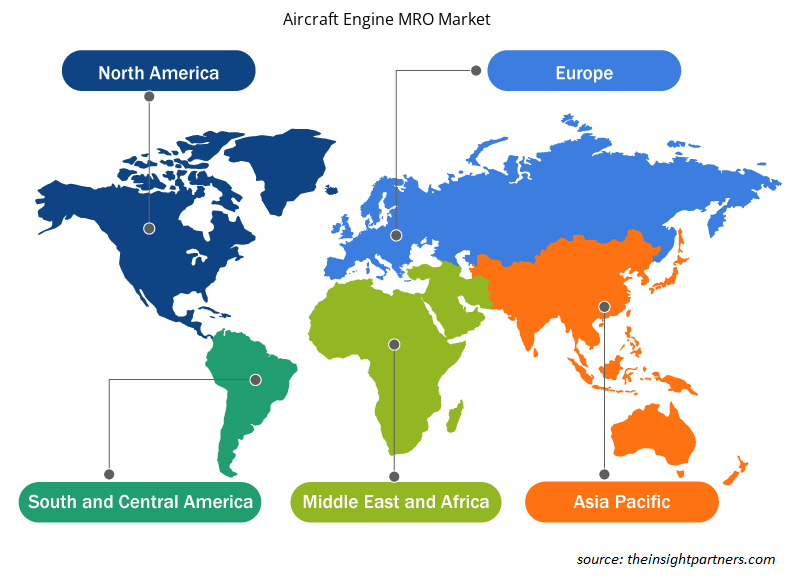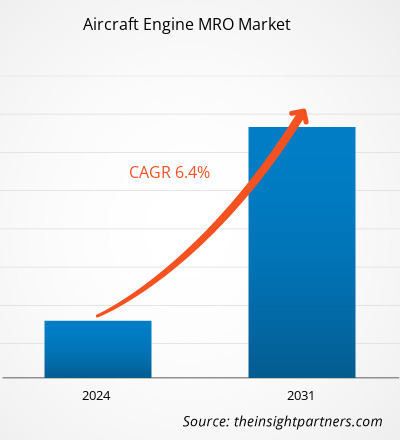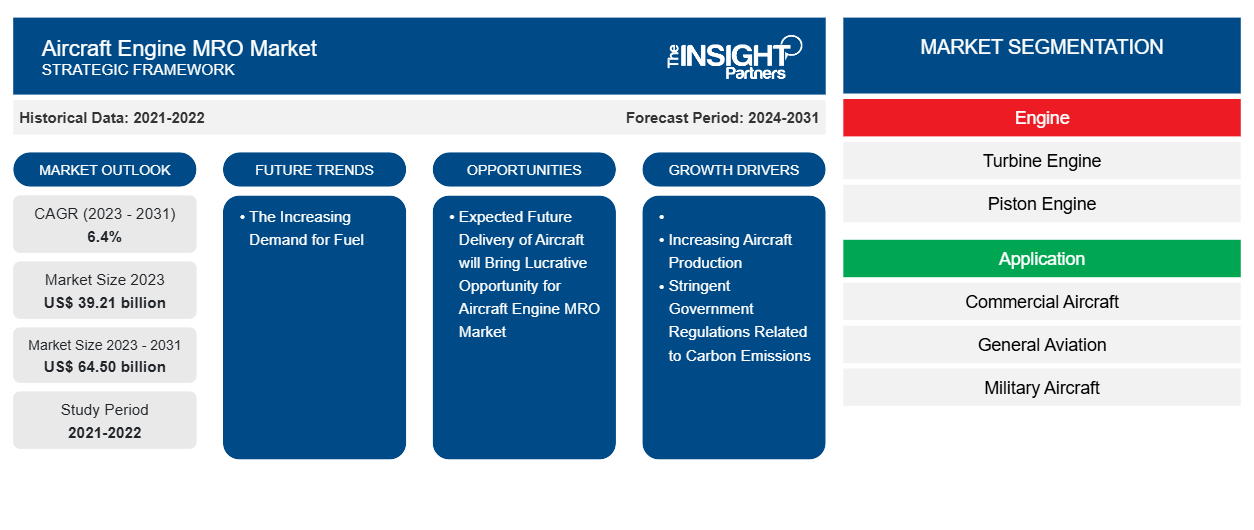항공기 엔진 MRO 시장 규모는 2023년 392억 1,000만 달러에서 2031년 645억 달러로 성장할 것으로 예상됩니다. 이 시장은 2023~2031년에 6.4%의 CAGR을 기록할 것으로 예상됩니다. 연료 효율 항공기에 대한 수요 증가는 주요 항공기 엔진 MRO 시장 추세로 남을 가능성이 높습니다.
항공기 엔진 MRO 시장 분석
전 세계 공항에는 다양한 유형의 엔진 MRO 시설이 있습니다. 일반적으로 유지관리는 항공기의 동체 또는 엔진에서 수행됩니다. 엔진 MRO 서비스에는 오늘날 구성품의 MRO도 포함됩니다. 서비스 유형에 따라 이러한 서비스는 공항에서 제공되며 때로는 공항 외부 시설에서 제공됩니다. 정기 검사, 정기적인 문제 해결 또는 일상적인 엔진 점검과 같은 활동은 항공기가 공항 터미널에 주차되어 있을 때 수행할 수 있습니다.
항공기 엔진 MRO 시장 개요
항공기 엔진 MRO의 주요 응용 분야 중 하나는 엔진의 모든 회전 단계가 균형을 이루고 최소 진동 수준을 유지하는 것입니다. 이를 통해 엔진의 내구성과 연료 효율이 향상되고 진동으로 인한 엔진 마모량이 제한됩니다. 항공기 엔진과 관련 구성 요소를 업그레이드하면 항공기 엔진 MRO에 대한 고급 인프라와 숙련된 노동력에 대한 필요성도 증가합니다. 엔진의 MRO 요구 사항은 엔진의 유형과 범주에 따라 다릅니다. 오래되고 작은 항공기 엔진은 최대 5,000시간의 오버홀(TBO) 간격이 있습니다. 최신 엔진은 6,000시간 이상의 TBO가 있습니다. 연간 500시간 미만으로 비행하는 비즈니스 항공기가 많아지면서 엔진 MRO 서비스 요구 사항은 평균 12년 이상입니다.
귀하의 요구 사항에 맞게 이 보고서를 사용자 정의하세요
이 보고서의 일부 또는 국가 수준 분석, Excel 데이터 팩을 포함하여 모든 보고서에 대한 사용자 정의를 무료로 받을 수 있으며 신생 기업 및 대학을 위한 훌륭한 혜택과 할인 혜택을 이용할 수 있습니다.
-
이 보고서의 주요 시장 동향을 알아보세요.이 무료 샘플에는 시장 동향부터 추정 및 예측까지 다양한 데이터 분석이 포함됩니다.
항공기 엔진 MRO 시장 동인 및 기회
탄소 배출과 관련된 엄격한 정부 규제
2021년 미국 정부는 2030년까지 항공기 배출량을 20% 줄이겠다는 목표를 발표했습니다. 여러 규제 기관이 탄소 배출량을 줄이기 위한 전략을 실행하고 있습니다. 예를 들어, 2022년 3월 국제항공운송협회(IATA)는 2050년까지 연간 100억 건 이상의 항공편이 운항될 것으로 추정 하고 2050년까지 탄소 순배출량을 0으로 줄이겠다고 발표했습니다.
전 세계 국가의 60% 이상이 탄소 순배출량을 제로로 선언했습니다. Honeywell Aerospace와 같은 회사도 2035년까지 탄소 순배출량을 제로로 달성하기 위해 노력하고 있습니다. 2021년 11월 Bell Textron Inc.는 Bell 525가 지속 가능한 항공 연료를 사용하여 첫 비행을 완료했다고 발표했습니다. Boeing과 Airbus는 최근 2030년까지 항공기가 100% SAF로 비행할 것이라고 발표했습니다. 미국과 유럽 정부는 SAF를 생산하도록 권장됩니다. 이러한 요인들이 항공기 엔진 MRO 시장을 상당히 촉진하고 있습니다.
상업용 항공기의 미래 예상 인도 – 항공기 엔진 MRO 시장의 기회
항공 교통량과 항공기 수요가 증가함에 따라 항공사는 항공기 인도를 늘리고 있습니다. 신규 항공사에 대한 수요는 기존 항공기가 함대를 재편성하는 것뿐만 아니라 시장에 진입하는 새로운 저비용 항공기에서도 발생합니다. 팬데믹 이후 레저 여행객의 비용 민감성이 낮아지고, 비즈니스 여행에 대한 관심이 감소하고, 최소 비용 항공기 행동 계획의 적응성이 MRO 서비스에 대한 수요를 급증시키고 있습니다. 게다가 보잉과 에어버스의 예측에 따르면 2042년 말까지 40,800대 이상의 상업용 항공기가 인도될 것으로 예상되어 이러한 항공기 생산에 새로운 엔진을 배치하는 것이 더욱 촉진됩니다. 이를 통해 전 세계적으로 전체 항공기 함대가 더욱 증가하고 향후 몇 년 동안 엔진 MRO와 시장 공급업체에 대한 수요가 발생할 것입니다.
항공기 엔진 MRO 시장 보고서 세분화 분석
항공기 엔진 MRO 시장 분석에 기여한 주요 부문은 엔진, 응용 분야, 항공기 유형입니다.
엔진[터빈엔진(터보프롭엔진, 터보팬엔진, 터보샤프트엔진), 피스톤엔진], 적용분야(상업용 항공기, 일반항공, 군용 항공기), 항공기 유형(고정익, 회전익)
- 엔진을 기준으로 항공기 엔진 MRO 시장은 터빈 엔진과 피스톤 엔진으로 세분화됩니다. 또한 터빈 엔진은 터보프롭 엔진, 터보팬 엔진, 터보샤프트 엔진으로 세분화되었습니다. 터빈 엔진 세그먼트는 2023년에 더 큰 시장 점유율을 차지했습니다.
- 응용 프로그램을 기준으로 시장은 상업용 항공기, 일반 항공 및 군용 항공기로 세분화됩니다. 상업용 항공기 부문은 2023년에 더 큰 시장 점유율을 차지했습니다.
- 항공기 유형에 따라 시장은 고정익과 회전익으로 세분화됩니다. 고정익 세그먼트는 2023년에 더 큰 시장 점유율을 차지했습니다.
지역별 항공기 엔진 MRO 시장 점유율 분석
항공기 엔진 MRO 시장 보고서의 지리적 범위는 주로 북미, 아시아 태평양, 유럽, 중동 및 아프리카, 남미의 5개 지역으로 나뉩니다.
2023년에 아시아 태평양 지역은 글로벌 항공기 엔진 MRO 시장에서 주요 점유율을 차지했으며, 그 뒤를 북미와 유럽이 따랐습니다. 아시아 경제는 다양한 소득 수준과 빠르게 확장되는 중산층에 의해 촉진되었습니다. 이로 인해 인도와 중국과 같은 이 지역의 빠르게 성장하는 경제에서 강력한 매출 성장이 이루어졌습니다. APAC은 항공기 MRO 서비스 공급업체에 대한 전망이 가장 높은 시장으로 예상됩니다. 이 지역에는 항공우주, 군사 및 방위, 기술과 같은 다양한 산업을 선도하는 여러 개발도상국이 있습니다. APAC의 많은 성장 경제권은 기술을 개선하기 위해 규제 투자를 모색하고 있습니다. 이는 결국 항공기 통합을 위한 새로운 기술의 개발과 사용을 촉진할 것입니다 . 싱가포르 항공과 말레이시아 항공과 같은 APAC의 여러 항공사는 자체 유지 관리 역량을 개발하고 있습니다. 미국의 항공우주 기업인 프랫앤휘트니는 2019년 싱가포르의 Eagle Services Asia 공장에서 PW100G-JM 기어드 터보팬에 대한 MRO 기능을 추가했습니다. 이 공장은 수년에 걸쳐 프랫앤휘트니 GTF 엔진을 정비해 왔습니다. PW100G-JM 엔진이 출시됨에 따라 이 시설은 PW100G-JM을 사용하는 다양한 항공기 운영자로부터 상당한 수익 증가를 보일 것으로 예상됩니다. 또한 개선된 항공기에 대한 개조 기술의 증가와 블록체인 기술의 급증하는 채택은 항공기 엔진 MRO 시장 성장을 견인하는 주요 요인 중 일부입니다. 또한 아시아 태평양 시장 성장은 여객 교통량 증가로 인한 항공기 함대 증가, 국방 예산 증가로 인한 군용 항공기 지출 증가, 상업용, 일반 항공 및 군용 항공기 개발 프로젝트 진행에 기인합니다.
항공기 엔진 MRO 시장 지역 통찰력
Insight Partners의 분석가들은 예측 기간 동안 항공기 엔진 MRO 시장에 영향을 미치는 지역적 추세와 요인을 철저히 설명했습니다. 이 섹션에서는 북미, 유럽, 아시아 태평양, 중동 및 아프리카, 남미 및 중미의 항공기 엔진 MRO 시장 세그먼트와 지리에 대해서도 설명합니다.

- 항공기 엔진 MRO 시장에 대한 지역별 특정 데이터 얻기
항공기 엔진 MRO 시장 보고서 범위
| 보고서 속성 | 세부 |
|---|---|
| 2023년 시장 규모 | 392억 1천만 달러 |
| 2031년까지 시장 규모 | 645억 달러 |
| 글로벌 CAGR (2023-2031) | 6.4% |
| 역사적 데이터 | 2021-2022 |
| 예측 기간 | 2024-2031 |
| 다루는 세그먼트 |
엔진별
|
| 포함된 지역 및 국가 |
북아메리카
|
| 시장 선도 기업 및 주요 회사 프로필 |
|
시장 참여자 밀도: 비즈니스 역학에 미치는 영향 이해
항공기 엔진 MRO 시장은 소비자 선호도의 변화, 기술 발전, 제품의 이점에 대한 인식 증가와 같은 요인으로 인해 최종 사용자 수요가 증가함에 따라 빠르게 성장하고 있습니다. 수요가 증가함에 따라 기업은 제품을 확장하고, 소비자의 요구를 충족하기 위해 혁신하고, 새로운 트렌드를 활용하여 시장 성장을 더욱 촉진하고 있습니다.
시장 참여자 밀도는 특정 시장이나 산업 내에서 운영되는 회사나 기업의 분포를 말합니다. 주어진 시장 공간에 얼마나 많은 경쟁자(시장 참여자)가 존재하는지 그 규모나 총 시장 가치에 비해 나타냅니다.
항공기 엔진 MRO 시장에서 운영되는 주요 회사는 다음과 같습니다.
- 델타 항공 주식회사
- GE 항공
- CFM 인터내셔널
- 루프트한자 테크닉
- MTU 에어로 엔진 AG
- SIA 엔지니어링 회사
면책 조항 : 위에 나열된 회사는 어떤 특별한 순서에 따라 순위가 매겨지지 않았습니다.

- 항공기 엔진 MRO 시장 주요 주요 업체 개요를 알아보세요
항공기 엔진 MRO 시장 뉴스 및 최근 개발
항공기 엔진 MRO 시장은 1차 및 2차 조사 이후의 정성적, 정량적 데이터를 수집하여 평가합니다. 여기에는 중요한 기업 간행물, 협회 데이터 및 데이터베이스가 포함됩니다. 다음은 혁신, 사업 확장 및 전략에 대한 시장의 개발 목록입니다.
- 2024년 4월, ITP Aero는 콜롬비아 국방부와 Black Hawk 헬리콥터의 군단에 동력을 공급하는 T700 엔진의 유지, 수리 및 정비(MRO) 계약을 체결했습니다. 이 계약은 2026년 6월까지 유효하며, 엔진의 MRO 서비스는 알바세테(스페인)에 있는 ITP Aero 시설에서 수행됩니다. (출처: ITP Aero, 보도자료)
- 2023년 11월, MTU Maintenance는 스리랑카 항공과 5년 LEAP-1A 유지보수, 수리 및 정비(MRO) 계약을 체결하여 두 회사의 기존 관계를 기반으로 V2500 엔진과 리스 지원도 담당했습니다. 스리랑카의 국영 항공사는 현재 22대의 에어버스 A330과 A320/A321 항공기를 운항하고 있으며 남아시아, 유럽, 극동 및 중동 전역으로 항공편을 운항합니다. (출처: MTU Maintenance, 뉴스레터)
항공기 엔진 MRO 시장 보고서 범위 및 제공물
"항공기 엔진 MRO 시장 규모 및 예측(2021-2031)" 보고서는 다음 영역을 포괄하는 시장에 대한 자세한 분석을 제공합니다.
- 범위에 포함된 모든 주요 시장 세그먼트에 대한 글로벌, 지역 및 국가 수준의 항공기 엔진 MRO 시장 규모 및 예측
- 동인, 제약 및 주요 기회와 같은 시장 역학
- 항공기 엔진 MRO 시장 동향
- 포터의 5가지 힘에 대한 자세한 설명
- 항공기 엔진 MRO 시장 분석은 주요 시장 동향, 글로벌 및 지역 프레임워크, 주요 업체, 규정 및 최근 시장 개발 사항을 다룹니다.
- 시장 집중도, 히트맵 분석, 유명 업체 및 최근 개발 사항을 포함하는 항공기 엔진 MRO 산업 현황 및 경쟁 분석
- 자세한 회사 프로필
- 과거 분석(2년), 기준 연도, CAGR을 포함한 예측(7년)
- PEST 및 SWOT 분석
- 시장 규모 가치/거래량 - 글로벌, 지역, 국가
- 산업 및 경쟁 환경
- Excel 데이터세트
최근 보고서
사용 후기
구매 이유
- 정보에 기반한 의사 결정
- 시장 역학 이해
- 경쟁 분석
- 고객 인사이트
- 시장 예측
- 위험 완화
- 전략 기획
- 투자 타당성 분석
- 신흥 시장 파악
- 마케팅 전략 강화
- 운영 효율성 향상
- 규제 동향에 발맞춰 대응























 무료 샘플 받기 - 항공기 엔진 MRO 시장
무료 샘플 받기 - 항공기 엔진 MRO 시장